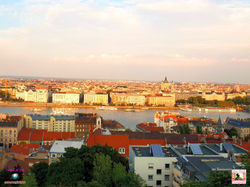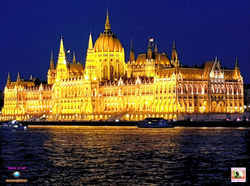top of page

 Budapest, the capital of Hungary, was founded in 1873 by the merger of three cities: Buda, Óbuda and Pest. Today, Buda is usually associated with stately quarters and high class, Pest is where you will find the largest part of the population and so-called urban living. Buda and Pest are connected by the magnificent bridge of Széchenyi (known as the ‘Chain Bridge’). |
|---|
 Danube RiverBudapest, Twin Cities on the Danube River |
 Panoramic view of Budapest |
 Panoramic view of Budapest |
 The river Danube is Europe’s 2nd longest river, it runs through 10 countries (and 4 capitals) from the Black Forest (Germany) to the Black Sea (Romania and Ukraine). |
 Budapest Skyline |
 Széchenyi Chain Bridge over the River DanubeThe Chain Bridge was the first bridge to permanently connect Buda and Pest. At the time of its completion, Chain Bridge was considered to be one of the wonders of the world. |
 Chain Bridge |
 Liberty Bridge over the River DanubeLiberty bridge is connecting the Pest side at Fovam Square with the side Buda Gellert Square and is probably the most popular bridge in Hungary. Liberty Bridge is the third oldest and also the smallest bridge in Budapest, only 333 meters long and 20 meters wide. |
 The river Danube is a truly international river, which flows through ten countries. Only about 10% of the waters of the river are going through Hungary |
 Heroes’ SquareHeroes’ Square is the largest and most impressive square of the city. The Millennium Monument standing in the middle of the square was erected in 1896 to commemorate the 1000th anniversary of the Magyars’ arrival to the Carpathian Basin. |
 Fisherman's BastionFisherman's Bastion was built between 1895 and 1902 on Buda's Castle Hill not to provide protection, but rather as a lookout tower for the best panoramic views in Budapest |
 Castle HillCastle Hill is a kilometre-long limestone plateau towering 170m above the Danube. It contains some of Budapest’s most important medieval monuments and museums and is a Unesco World Heritage Site. |
 Buda CastleFacing over the Danube, Budapest's Castle Hill (Várhegy) contains many of the city's most important medieval monuments and museums. Topping the list of these impressive structures is the 18th-century Buda Castle (Budavári Palota), a massive 200-room palace that replaced a 13th-century castle built to protect the stronghold from Mongol and Tartar attacks. |
 Buda CastleThe current incarnation of Buda Castle (Budavári Palota), also sometimes called the Castle Palace, is a massive 18th-century, Neo-Baroque-style structure of more than 200 rooms. These are arranged in a symmetrical layout around the 62-meter-high central dome facing the Danube. |
 Illuminated Buda Castle |
 Hungarian Parliament BuildingIt is located on the eastern bank of the Danube River and in the Pest side of the city |
 Hungarian Parliament BuildingPlanning of the building started after the 19th-century unification of Budapest |
 Hungarian Parliament BuildingIt was built in the Gothic Revival style and features a Renaissance dome |
 Hungarian Parliament BuildingA labor force of 100,000 was involved to cement the 40 million bricks together. The building was elaborately finished with about half a million precious stones and 40 kilograms (88 lb) of gold. |
 Illuminated Hungarian Parliament BuildingIt took nearly 2 decades for the building to be completed |
 Illuminated Hungarian Parliament BuildingThe Hungarian Parliament Building is the 3rd-largest national assembly in the world. |
 Illuminated Hungarian Parliament BuildingThe building blends elements and motifs of various architectural styles: its floor plan is Baroque, the façade ornamentation evokes the world of Gothic, and the decoration of the ceiling shows stylistic elements of the Renaissance. |
bottom of page